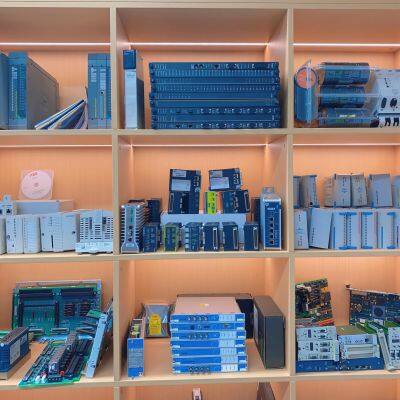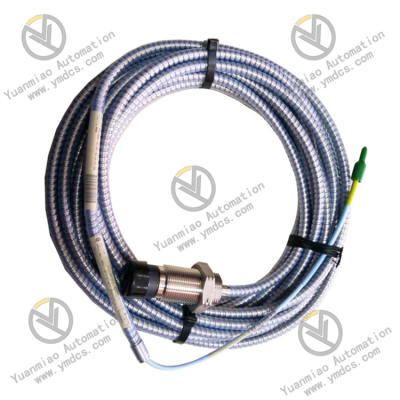Product Description
Summary of 3500 Series Modules
I. Overview
BENTLY 22810-01-05-50-02 is a high-reliability vibration monitoring system that plays a crucial role in ensuring the stable and efficient operation of various mechanical equipment. In industrial production, the vibration status of mechanical equipment is one of the key indicators reflecting its operating condition. Even minor abnormal vibrations may indicate potential fault risks, such as component wear, loosening, and imbalance. Targeting this demand, BENTLY 22810-01-05-50-02 is dedicated to the accurate measurement and in-depth analysis of mechanical equipment vibrations, providing strong support for the safe operation and performance optimization of equipment.
This system integrates advanced sensing technology and intelligent signal processing algorithms, enabling it to sensitively capture various vibration signals generated by equipment during operation. Whether it is high-frequency subtle vibrations or low-frequency large-amplitude vibrations, the system can accurately identify and convert them into analyzable data. Thanks to its excellent design and manufacturing processes, BENTLY 22810-01-05-50-02 can maintain stable and reliable working performance even in complex and harsh industrial environments, such as high-temperature, high-humidity, and strong electromagnetic interference environments. It has become a trusted and effective assistant for equipment condition monitoring in many industrial enterprises.
II. Technical Specifications
(1) Power Supply Parameters
The system operates at a working voltage of 24VDC. This DC power supply method features high stability and strong anti-interference capabilities, which can provide continuous and stable electrical energy for various precision electronic components inside the system. This ensures that the system will not experience monitoring errors or malfunctions due to voltage fluctuations during long-term operation. In industrial scenarios with extremely high requirements for power supply stability—such as the monitoring of key pump units in chemical production and steam turbines in power generation—the 24VDC power supply design can effectively ensure the stable operation of the vibration monitoring system, laying a solid power foundation for the reliable operation of equipment.
(2) Output Frequency
Its output frequency is 1kHz. This frequency setting allows the system to quickly and timely transmit the collected vibration data to subsequent data analysis and processing units. During equipment operation, the vibration status may change rapidly; a relatively high output frequency ensures that the monitoring system does not miss any critical vibration information, and promptly transmits real-time data to operators or automated control systems for quick responses. For example, in the operation monitoring of large compressors, if a mechanical fault inside the compressor causes abnormal vibrations, the 1kHz output frequency enables the monitoring system to quickly capture this change and transmit relevant data to the control system. The control system can then take timely measures, such as adjusting the compressor’s operating parameters or activating protection mechanisms, to prevent further deterioration of the equipment fault.
(3) Signal Processing Capabilities
The system is equipped with an advanced signal processing module, featuring powerful filtering, amplification, and feature extraction functions. In complex industrial environments, equipment vibration signals are often mixed with various noise interferences. Through carefully designed filtering algorithms, the system can effectively eliminate useless signals such as environmental noise and electromagnetic interference, while retaining pure equipment vibration characteristic signals. At the same time, it accurately amplifies weak vibration signals to improve the signal-to-noise ratio, facilitating more accurate analysis of the equipment’s vibration status in subsequent processes. Using feature extraction algorithms, the system can extract key characteristic parameters (such as vibration amplitude, frequency, and phase) from the original vibration signals, providing rich and accurate data support for equipment fault diagnosis. For instance, by analyzing changes in vibration amplitude, it is possible to determine whether equipment components are worn or loose; by monitoring abnormal vibration frequencies, it can identify faults such as equipment resonance.

III. Functional Features
(1) Real-Time Vibration Analysis
BENTLY 22810-01-05-50-02 can perform real-time online analysis of equipment vibrations. Through built-in intelligent algorithms, it compares the collected vibration data with pre-set normal operating parameter models. Once the monitored vibration data exceeds the normal range, the system can quickly issue an early warning signal and conduct in-depth analysis of the type, location, and potential causes of the abnormal vibration. For example, when abnormal vibrations of a motor are detected, the system can analyze the vibration spectrum to determine whether the vibration problem is caused by motor rotor imbalance, bearing wear, or faults in other mechanical components. This provides maintenance personnel with a clear direction for fault diagnosis, significantly shortening the time required for equipment fault detection and improving equipment maintenance efficiency.
(2) Preventive Maintenance Support
Leveraging its real-time vibration analysis function, the system provides strong support for industrial enterprises to implement preventive maintenance of equipment. By continuously monitoring and analyzing equipment vibration data over the long term, the system can establish an operational health record for the equipment and predict the time and type of potential faults. Enterprises can use this predictive information to formulate maintenance plans in advance and arrange maintenance personnel to conduct targeted maintenance (such as replacing worn components or adjusting equipment operating parameters) before faults occur. This preventive maintenance strategy can effectively avoid problems such as production interruptions and increased maintenance costs caused by sudden equipment faults, extend the service life of equipment, and reduce the overall operating costs of enterprises. For example, in the maintenance of large rolling mills in steel production lines, with the preventive maintenance support of this vibration monitoring system, enterprises can replace vulnerable components (such as roll bearings) in advance, ensuring the continuous and stable operation of rolling mills and improving the efficiency and quality of steel production.
(3) Flexible System Integration
In terms of design, BENTLY 22810-01-05-50-02 fully considers compatibility and integration convenience with various industrial automation systems. It supports multiple common communication protocols (such as Modbus and Profibus) and can be easily integrated with existing enterprise automation equipment, including distributed control systems (DCS) and programmable logic controllers (PLCs), to achieve seamless connection. Whether it is for newly built modern industrial production lines or the intelligent transformation and upgrading of traditional industrial equipment, this vibration monitoring system can be quickly integrated into the overall automation architecture. It enables centralized management and collaborative analysis of equipment vibration data and other production process data. For example, in the automated production control system of a petrochemical enterprise, after integrating the BENTLY 22810-01-05-50-02 vibration monitoring system into the DCS, operators can simultaneously view equipment operating parameters, process data, and vibration status information on the monitoring screen of the central control room. This facilitates a comprehensive understanding of the operating conditions of production equipment and enables timely and scientific decision-making.
IV. Application Fields
(1) Power Generation Industry
In the power generation field, large rotating equipment such as steam turbines and generators are core equipment for power production. During high-speed operation, these devices have extremely strict requirements for vibration control; even minor abnormal vibrations may trigger serious equipment faults and affect the stability of power supply. The BENTLY 22810-01-05-50-02 vibration monitoring system can be installed at key locations such as the bearing seats of steam turbines and the stators and rotors of generators to monitor the vibration status of the equipment under different operating conditions in real time. For example, during the startup or shutdown of a steam turbine, the system can closely monitor changes in vibration amplitude and frequency to ensure the smooth transition of the equipment and avoid problems such as friction and damage to dynamic and static components caused by excessive vibrations. During the operation of generators, monitoring vibration signals can help detect potential faults such as rotor winding short circuits and bearing wear in a timely manner, ensuring the safe and reliable operation of power generation equipment and providing a solid guarantee for stable power supply.
(2) Petrochemical Industry
The petrochemical production process involves a large number of large-scale mechanical equipment, such as compressors, pump units, and reactor agitators. During long-term operation, these devices are prone to abnormal vibration problems due to factors such as medium corrosion, mechanical stress, and temperature changes. BENTLY 22810-01-05-50-02 can be widely used for vibration monitoring of these devices, helping enterprises detect potential equipment faults in a timely manner and ensuring the continuity and safety of chemical production. Taking large compressors as an example, the system can monitor the vibration status of compressors in real time. When abnormal vibrations caused by issues such as seal leakage or impeller scaling are detected, it promptly issues an alarm and provides a fault analysis report. Operators can then take corresponding measures (such as shutdown maintenance, impeller cleaning, and seal replacement) to prevent safety accidents such as production interruptions and material leakage caused by compressor faults, ensuring the smooth progress of the petrochemical production process.
GE IS200EGPAG1BCA Exciter Gate Pulse Amplifier Board
GE IS200EPSMG1AEC Exciter Power Supply Module
BENTLY 330100-90-00 Vibration Proximity Probe
BENTLY NEVADA 9200-01-01-10-00 Vibration Monitoring Module
CUTLER HAMMER 1755T-PMPP-1700 Industrial-Grade Human-Machine Interface
CUTLER-HAMMER 1775T-PMPS-1700 Industrial-Grade Human-Machine Interface


DALSA CR-GEN0-M6400R3 Industrial Line Scanning Camera
Entek 1440-VSE02-01RA Vibration Monitoring Module
GE IS200PMCIH1AAA6BA00 Programmable Logic Controller
GE IS200PDIOH1B Discrete I/O Module
GE IS200TSVCH1A Servo Input/Output Terminal Board
GE IS200STCIH2A I/O Module Terminal Board
GE IS200TRPAH2AHE Thermocouple Temperature Acquisition Module
BENTLY 3300/16-14-01-03-00-00-01 Dual Vibration Monitor
BENTLY NEVADA 3500/05-01-01-00-00-01 System Rack Datasheet
GE IS200WNPSH1ABA Power Supply Daughter Card
GE IS210WSVOH1AE Servo Driver Board
GE IS210AEPSG1AFC Power Supply Board
 yezi
Hi there! Welcome to my shop. Let me know if you have any questions.
yezi
Hi there! Welcome to my shop. Let me know if you have any questions.



